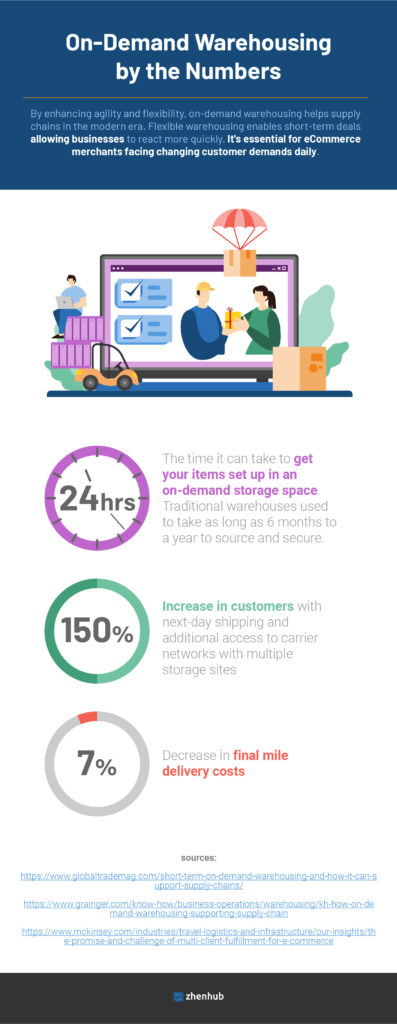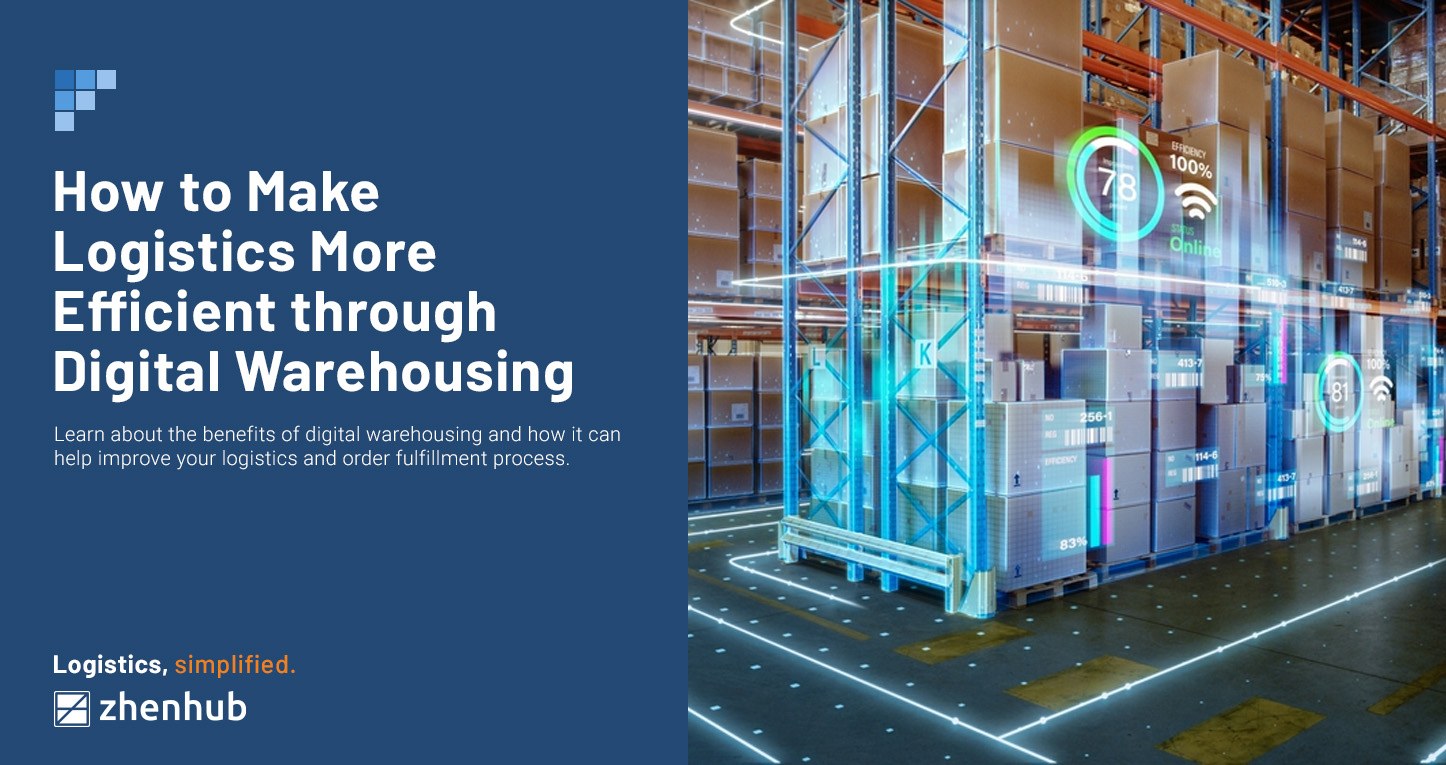
What is On-Demand Warehousing?
Time to read: 5 minutes
There are many moving parts in an eCommerce company’s operation. Supply chain management is hardly the first thing that comes into mind when considering an eCommerce business. However, it is an essential piece of the puzzle that impacts everything from customer deliveries to inventory management.
On-demand warehousing has highlighted how the sharing economy is transforming the modern logistics industry. Technology advances are driving shared warehousing adoption. It’s enabling businesses to scale up and rapidly meet customer demand. Upgraded systems are also more capable of responding to frequently shifting market conditions.
Retailers and brands can scale their businesses more efficiently and deal with inventory fluctuations with on-demand warehouses’ adaptable warehousing solutions. Shipping companies should consider adopting these tech solutions to improve their operations.
On-demand warehousing is essentially the service of sharing a warehouse. Consequently, companies with extra warehouse space can rent it to other companies who need to store merchandise.
Both parties stand to gain significantly from this. This is an excellent chance to develop a new income stream if you have extra warehouse space.
If you have extra inventory that has to be stored, employing an on-demand facility offers several key benefits. For instance, some warehouse tenants can hire warehouse personnel, and some might assist you in shipping your product to its final destination.
How On-Demand Warehousing Works
On-demand warehousing is a concept based on the fact that eCommerce companies, merchants, and shipping companies cannot always accurately forecast how to fully utilize their warehouse space.
As demand for certain products continues to rise, there is an increasing demand for large storage spaces. Whether you’re a small startup or an established company, meeting client needs and determining the need for storage space become paramount. Demand usually increases during Christmas or when you introduce a new product. But it tapers off eventually, leaving empty warehouses.
This strategy allows shipping firms and merchants to connect with on-demand warehousing providers that have extra storage space. eCommerce firms may easily locate warehouse and shipping fulfillment solutions using a pay-as-you-go agreement. It will free them from committing to lengthy agreements or paying hefty setup costs.
On-demand warehouses are promising due to their unparalleled agility. On-demand employs fewer pallets for a flexible period compared to third-party logistics providers (3PLs) with long-term leases with thousands of pallets.
Utilizing less space in more facilities is the essence of on-demand warehousing. Shipping companies can fill their orders faster than 3PLs, thanks to the overlap of functions between warehousing and distribution centers.
On-demand warehousing has a competitive advantage over other warehousing options combined with sophisticated tracking and product supply chain management.
On-demand warehousing offers a more environmentally friendly storage solution. Fewer resources are spent by encouraging resource sharing rather than the construction of new storage facilities. Renters can choose warehouse locations near their product’s final destinations. They can also use more efficient modes of transportation for strict customer delivery requirements. Dynamic resource sharing found via on-demand warehousing platforms powers faster deliveries.
Potential Advantages of On-Demand Warehousing
On-demand warehousing was initially developed as a solution to expanding needs for warehouse capacity. There have yet to be any options for this necessity, especially for non-3PLs. Companies requiring extra warehouse space, temporarily or in a different location, had to look for a warehouse space to lease or use a 3PL warehouse.
For warehouse lenders and renters looking for temporary storage or fulfillment services, on-demand warehousing offers several advantages:
1. Lower Fixed Costs
The flexibility of on-demand storage arrangements can shift more fixed expenditures to variable costs, reducing your risk exposure. Doing this will boost your bottom line to help secure more inventory, do more marketing, or staff hiring. Reducing fixed costs also means experimenting with new goods and distribution methods. It’ll also allow you to change strategies immediately if an idea doesn’t pan out.
2. Larger Warehousing Network
Storage search is streamlined and expanded. For instance: you can choose a provider from a list of candidates who meet the specifications and scope of your project. You can get started in weeks rather than months. Additionally, there are no startup costs, as opposed to traditional warehousing. You can add more warehouse locations quickly and easily if your technology, terms, and billing are standardized.
With on-demand warehousing, retailers can stock their items in several warehouses in a country. Doing so brings their inventory closer to their customers and cuts down on last-mile deliveries’ time in transit (TNT).
3. Maximized Warehouse Capacity
On-demand warehousing presents a unique revenue opportunity if you are a warehouse owner or operator. By leasing out your storage space, you can take advantage of seasonal products and ensure your warehouse is always stocked. Maximizing space allows you to gain additional profit by reaching fulfillment capacity. You can also gain valuable data into new market opportunities through resource sharing.
4. Supply Chain Resilience
A flexible fulfillment solution is necessary since many vendors face seasonal demand and significant market interruptions. Retailers can avoid paying high fees during the off-season by only paying for the space they use. Seasonal retailers can also increase their sales and marketing efforts during their busiest seasons without worrying about overhead. Scaling resources to match demand won’t be a problem when there is a slowdown in customer interest.

On-Demand Warehousing: Factors to Consider
Every online enterprise is different and requires customized warehouse solutions to deliver products to clients effectively. While typical 3PLs provide more security and long-term partnerships, on-demand warehouse providers offer new, adaptable solutions.
Fast-moving consumer goods (FMCG), industrial production, and the hospitality sector are among the industries that frequently profit from on-demand warehousing.
There are various application cases for smaller businesses, and large enterprises can innovate with their supply networks. Retail and e-commerce fulfillment is a significant and still developing industry.
On-demand warehousing and 3PL services each have advantages and disadvantages. But to meet your company’s goals, you must develop a solution that complies with consumer expectations and demands. Consider the following factors when deciding if on-demand warehousing is best for your business:
1. Number of SKUs
First, you must be sure of your company’s needs. Before choosing an on-demand warehousing service, it should include the storage type and amount of space needed. Warehouses typically use SKUs to estimate the required storage space and the associated expenses.
2. Product Requirements and Needs
Only some warehouses can handle goods with specific storage needs. For example, consider a warehouse fulfillment company with a big freezer to store your goods if you offer cold storage. In addition, some warehouses offer additional services including order fulfillment, product insurance, labeling, assembly, and processing. Some can provide packaging and inventory tracking.
3. Location
The location of your warehouse will undoubtedly impact your supply chain. The biggest impact will be how quickly your products will be produced and transported. In large cities, having a warehouse close to transportation hubs will facilitate a quicker and more effective order fulfillment process. Additionally, it will assist in exceeding the delivery timetable expectations of your clients.
It’s also worth considering the technological capabilities of the warehouse. Choose a warehouse with the technology and software that can help you track your shipments. Having efficient eCommerce fulfillment software will relieve your workload and automate procedures. It will also give you more time to concentrate on other areas of your company.
The suitability of on-demand warehousing solutions for your company depends on many variables, like choosing an efficient order fulfillment system. Ensure the on-demand warehouse service you select has the newest equipment and plenty of storage. It should also follow effective order distribution procedures.
You may develop a distribution network strategy that’s as flexible as on-demand warehousing. You can adjust your warehouse fulfillment network’s size and capabilities to fit changing demands and handle unforeseen challenges.
On-demand warehousing offers a low-risk way to test new strategies and keep up with rising customer expectations. There is no need for lengthy contracts or short-term agreements with exorbitant fees under a variable cost model.
Due to rising costs, warehousing, and order fulfillment concerns, on-demand warehousing will be the preferred option for retailers and brands. With the on-demand warehousing system, you can address problems like inventory fluctuation, scalability, and changing customer demand.
ZhenHub helps you get started with on-demand warehousing through our distribution network of global warehousing partners. Bring your products closer to your customers while reducing storage and shipping costs. Our digital platform also gives you complete oversight over stock and in-transit parcels. Sign up at our website now.


